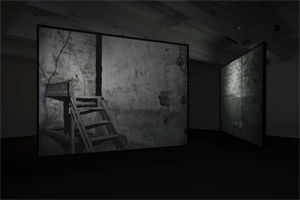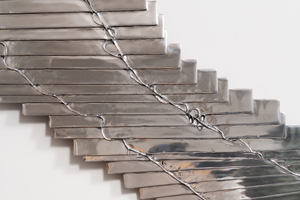Specific Enough
John Haberin New York City
Susan Philipsz and Jan Tichy
Anne Libby and Philip Seibel
Site-specific art has its virtues, even when you do not know that it came into being on-site. It makes you that much more aware of the art, yourself, and your shared surroundings.
It elevates the gallery and everyday experience to art and gives art its place in the gallery and in the everyday. It signals an institution's commitment to the artist and the artist's commitment to the viewer. But can it ever be site-specific enough? Consider the infrastructure, the very things that keep the site functional. Susan Philipsz, Jan Tichy, Anne Libby, and Philip Seibel all make it part of their work—  from the cables and wires supporting speakers and video to the covering of walls and windows. At least they seem to do so, but the art will not hide behind walls.
from the cables and wires supporting speakers and video to the covering of walls and windows. At least they seem to do so, but the art will not hide behind walls.
Where music went to die
I had come to Germany for the old masters, but I had to make time for those who would never reach old age. Dachau is only a day trip from Munich, but for German Jews there was no going back. I shall never hear their voices, but I remember most the silence. Not that the former concentration camp lacks proper aids to remembrance, but it marks the buildings, long since razed, with only their outlines on bare ground.
Dachau was a way station, a mere cog in the machinery of death, and mass killing took place further east, where those who wished could look away. And there Pavel Haas broke the silence. He wrote his Study for String Orchestra while at Theresienstadt, in Bohemia—and then, in a cruel twist of fate, the Nazis forced him to perform it as evidence of their kindness. A lonely creative act found a public, on site and in propaganda, even as his name, his work, and his fate were all but lost to history. He died in Auschwitz, the death camp in Poland, but Susan Philipsz hears his echoes to this day. She also adds a visual component so that others will remember as well.
Philipsz has been hearing voices for some time now, and her sound art is all about seeing ghosts. She appeared in 2010 in "Haunted," with work commissioned for the Guggenheim. When I caught it again at this very gallery, I spoke of it as about listening and overcoming terror, but the disembodied voices were her own. Not that she had reason to apologize. They seem all the stranger for it, and the Scottish artist has a lovely singing voice at that. She is still more impressive now, though, for transcending her limits, with Separated Strings.
They are separated because they are, necessarily, cut off from their maker, but also because she records the cellos and violas on two tracks, as accompaniment for video on two screens. She sought out where they first played for their captors, but the camera does not sit still. The performance becomes a tour of where prisoners went on their way to die. Its projection on twin screens becomes in turn a tour of the room in which one stands, facing blank walls. Philipsz foregoes the echo effect with which she treated voices before, but it still exists between past and present. It is site specific, for more than one site.
The exhibition continues upstairs, and so does the chamber orchestra. A dozen years ago, she used six speakers to make sound art physical and visible, but I distinguished it from the spatial illusion of Janet Cardiff and George Bures Miller, as in her loudspeaker choir for a motet by Thomas Tallis. As if in response, Philipsz now sets out twelve speakers, for the notes in a scale. Here the separation changes, so that each speaker chimes in when its note sounds out. Tallis himself wrote in Tudor England, and a third work returns to vocal music for Ben Jonson, the Elizabethan playwright. His poem emanates from a steel drum meant for beer or gas.
Philipsz has a way of overthinking things. I could not hear the distinct separations of strings in separate works, and I am not sure that I should care. The vocal might as well be picking up the same song, and why a drum? Still, she feels things, from her ears down to her bones. The drum speaks up only as one nears it, and the strings give new meaning to surround sound. From now on, there can be no history of the past century without Haas—and there can be no hearing his music without seeing where it went to die.
Installing the light
Jan Tichy invites others into darkness in order to see the light. Is this really night? His photogravures will have you asking again and again. The steel frame of a future high rise looks all the more dangerous and seductive for its dark surroundings. A high, angled point of view sends the beams every which way, for a wild two-dimensional geometry that can never lose sight of the rigid three-dimensional grid. Light reflecting off the beams has its unpredictable patterns as well, like an artist's freehand doodling.
In a preternaturally dark room, perfect rectangles let in the light. Blocks and tubes rise within other interiors, seeming to emit their own softer light. Are the first ordinary windows in sunlight? Are the objects set within spaces much like the one in which you stand or scale models that you can only admire for their perfection? You could spend a very long time trying to decipher twenty other prints, from a series of forty—or give up trying, let Tichy arrest time, and enjoy the light. Everyday surroundings, he reminds you, have their own glow and their own geometric abstraction, more varied than you ever knew.
These are at once photographs and etchings, composed by hand and manufactured by light. They are also art objects, with thick borders of plain paper, for an additional source of white. Metal rods set them an inch or two off the wall. Titled Installations, they depict the fabric of the city and the artist's constructions, without distinguishing the two. They are themselves part of the urban fabric as well. For another artist, that would be more than enough for a show, but then come actual installations, one behind a black curtain and one downstairs.
They are also projections, for they, too, are about darkness and light. As I entered the first, another pure white rectangle descended to the floor, like the shaft of an elevator—and then the far wall lit up with another rectangle began rising. Soon enough, it spread into a more mottled field of light, like a wall painting for Sol LeWitt. Downstairs, the texturing comes first and foremost. Projections there have vertical divisions, like hard-edged abstraction on multiple panels for Ellsworth Kelly. They also refashion the basement walls into the concrete of Lower East Side exteriors.
Still, they are site-specific installations. They incorporate the gallery's infrastructure, and then they bring their own. Upstairs, behind that curtain, a cable could supply electricity for the whole, if only it would. It descends from the ceiling, coils into nested circles on the floor, and fragments into loose wires. It has the shape of a snake-charmer's magic act and the texture of rope. A single projector at floor level could not account for so many mind games and created visions.
Work like this invites the viewer to feel clever, and I succumbed to the invitation myself with his last show. In trying to complement it, I buried the art, and I am not proud of that. There Tichy brought light fixtures, like James Turrell and Dan Flavin, to his Minimalist structures and Post-Minimal illusions. Now more than ever he effaces the boundaries between new and old media, light and object, installation and architecture. He calls the show "Infra Structures" at that. It evokes found and created structure, visible structure and not always visible light.
Inside infrastructure
Infrastructure may not be the most important part of the gallery—not to art more concerned with space or art that relies on natural light. And indeed most site-specific work looks elsewhere. Philipsz allows sound art to reflect off bare walls, but she situates the work elsewhere entirely, in the terrors of a concentration camp. Tichy calls attention to every nook and cranny, with projections on surrounding walls, but his photos come from all over New York, and his title, "Infra Structure" gives equal weight to structure and light.  As for Anne Libby and Philip Seibel, their work only looks as if it preceded them. Who needs found infrastructure or infrared light when the artists can create their own?
As for Anne Libby and Philip Seibel, their work only looks as if it preceded them. Who needs found infrastructure or infrared light when the artists can create their own?
That dialogue between art and installation should seem familiar by now. Why worry about electrical outlets and electric lights amid the majesty of movable walls and trapezoidal windows at the former Whitney Museum, by Marcel Breuer? Richard Artschwager makes over the elevators in the new Whitney, but with fake textures. Carl Andre sticks to the floor, but woe to those who kick his metal tiles out of place. Assemblage by Bat-Ami Rivlin could almost bring the gallery up to code in case of emergency. Yet it rests on the floor at the center of the gallery, on its own.
Artists, though, have every reason to explore the gallery. Libby and Seibel, for that matter, have more than most. Six months ago, their gallery moved five blocks south and east, right across from the Manhattan entrance to the Manhattan Bridge. One could hardly escape the presence of its old quarters, with its cramped main space and disappointingly small basement, but one might prefer to ignore it. Now an entire building stands as an invitation to explore. I still feel the draw.
Here anything looks inviting, stairs included. And downstairs an artist dares you to put her down. Ebecho Muslimova seems preoccupied enough, with her cartoon style and signature plump nude. She stares at her own reflection in water, without the last care for drowning. She revels in the S of S&M, all the happier that it leaves her images anything but erotic. Her very silliness gets an added punch from enamel on aluminum.
To my mind, she sure needs it, but Libby and Seibel, too, are ambivalent about presence and restraint. Their infrastructure refuses to hide, but it also refuses to work. Libby mimics Venetian blinds, and she gains from the translucency of glass as well. Yet she has cast some in metal and brought her own colors to the rest. It also takes the shape of shelving or chairs. Two pieces do stick to the walls, where the slats punctuate a rippling across.
She calls her work, "Inner Green Echo," and I cannot swear that it is eco-friendly, but its echo is within. Seibel, based in Berlin, calls his "Gehäuse," an enclosure but also a private house or private study. His objects could seem native to the room as well, if only you could recognize them. Pressed wood and metal rectangles could pass for electric meters but bear nested images and protrude bluntly, well overheard. Freestanding sculpture fills out the show with wire and spots of ink. When it comes to infrastructure, who can say just what is at home, in the gallery or in life?

Susan Philipsz ran at Tanya Bonakdar through February 25, 2003, Jan Tichy at Fridman through February 18. Anne Libby, Philip Seibel, and Ebecho Muslimova ran at Magenta Plains through February 25.




